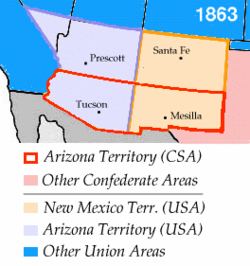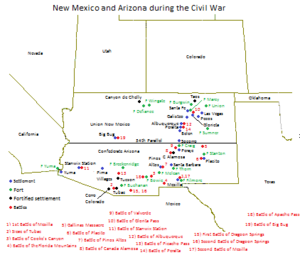- Arizona Territory (Confederate States of America)
-
Confederate Territory of Arizona Organized incorporated territory of the Confederate States of America ← 
1861–1865  →
→
 →
→Flag
Union and Confederate claims in Arizona and New Mexico during 1861-1865. The 1863 date reflects the establishment of the US Arizona Territory. Capital Mesilla Government Organized incorporated territory Governor - 1861 Lewis Owings (provisional) - 1861-1862 John Baylor - 1862-1865 Lewis Owings Historical era American Civil War - Mesilla Convention March 18, 1861 - Ordinance of Secession March 28 1861 - Battle of Mesilla July 25, 1861 - Admission to the Confederacy February 14, 1862 - Exile of the territorial government July 1862 - Surrender of the Confederacy April 9, 1865 Engagements in Confederate Arizona- 1st Mesilla
- Tubac
- Cooke's Canyon
- Florida Mountains
- Gallinas Mountains
- Placito
- Pinos Altos
- Canada Alamosa
- Valverde
- Stanwix Station
- Picacho Pass
- Tucson
- 1st Dragoon Springs
- 2nd Dragoon Springs
- 2nd Mesilla
- Apache Pass
- La Paz
- Mowry
- Mount Gray
- Doubtful Canyon
- Fort Buchanan
Confederate States
in the
American Civil WarSouth Carolina
Mississippi
Florida
Alabama
Georgia
Louisiana
Texas
Virginia
Arkansas
North Carolina
TennesseeDual governments Border states Delaware
Maryland
West VirginiaTerritories Indian
ArizonaThe Territory of Arizona was a territory claimed by the Confederate States of America during the American Civil War, between 1861 and 1865. It consisted of the portion of the New Mexico Territory south of the 34th parallel north including parts of the modern states of New Mexico and Arizona. Its capital was Mesilla along the southern border. The Confederate territory overlapped, but was not identical to the Arizona Territory created by the United States in 1863.
The territory was officially declared on August 1, 1861, following the Confederate victory at the Battle of Mesilla. Confederate hold in the area was soon broken, however, after the Battle of Glorieta Pass, the defining battle of the New Mexico Campaign. In July 1862, the government relocated to El Paso, Texas where it remained for the duration of the war.
However, the territory continued to be represented in the Confederate Congress and Confederate troops continued to fight under the Arizona banner until the war's end.
Contents
History
Origins of Secession
Before the start of the war the land of the current states of New Mexico and Arizona was part of the New Mexico Territory and the Gadsden Purchase which ran parallel to William Walker's Republics of Lower California and Sonora. As early as 1856 concerns had been raised about the ability of the territorial government in Santa Fe to effectively govern the southern part of the territory which was separated by the Jornada del Muerto, a difficult stretch of desert.
In February 1858, the New Mexico territorial legislative adopted a resolution in favor of the creation of the Arizona territory, but with a north-south border along the 32nd meridian west from Washington with the additional stipulation that all the Indians of New Mexico would be removed to northern Arizona.
In April 1860, impatient for Congress to act, a convention was called and 31 delegates met in Tucson. In July 1860, the convention drafted a constitution for a "Territory of Arizona" to be organized out of the New Mexico Territory south of 34° N. The convention elected Lewis Owings as the Territorial Governor, and elected a delegate to Congress.
The proposal, however, did not succeed in Congress because of opposition from anti-slavery Congressmen because many people in the area were pro-slavery with business connections in southern states, and this new territory lay below the old Missouri Compromise line of demarcation between slave and free states. Thus anti-slavery Congressmen feared the new territory might eventually become a slave state.
Since the proceedings of the Tucson convention never were ratified by the United States Congress the Provisional Territory never became a legal entity. However for a time it did operate as a de facto, if not de jure, government for the intended Arizona Territory. Dr. Lewis Owings, Governor of the Provisional Territory, appointed James Henry Tevis to raise the first Territorial Militia which comprised three companies of Arizona Rangers for the protection of the Territory from marauding Apaches and bandits. [1] Two companies were raised in the Pinos Altos mining camp and another at Mesilla.
Secession
After the start of the American Civil War support for the Confederacy was strong in the southern part of the New Mexico Territory largely due to its neglect by the United States government. Other concerns were the lack of substantial numbers of troops to fight the Apaches who were terrorizing travelers, ranches and mining camps all over Traditional Arizona following the Bascom Affair. Another was the closing of the Butterfield Overland Mail stations which connected the Arizona frontier colonies to the East and California. The Arizonans felt abandoned which fueled dissatisfaction for the federal government.
In March 1861, the citizens of Mesilla called a secession convention to separate themselves from the United States and join the Confederacy.
On March 16 the convention adopted a secession ordinance citing the region's common interests and geography with the Confederacy, the need of frontier protection and the loss of postal service routes under the United States government as reasons for their separation.[2] The ordinance proposed the question of secession to the western portions of the territory and on March 28 a second convention in present day Tucson, Arizona also met and ratified the ordinance.
The conventions subsequently established a provisional territorial government for the Confederate "Territory of Arizona." Owings was again elected as provisional governor and Granville Henderson Oury was chosen as a delegate to petition for the territory's admission into the Confederacy.
Civil War
The Confederate Arizona Territory was important to the role of the New Mexico Territory in the American Civil War primarily because it offered Confederate access to Union California. Consequently it was the scene of several important battles in the war's Trans-Mississippi Theater.
The rebels established a military post Fort Yuma on the banks of the Colorado River in 1862 adjacent to the Union army post with the same name on the other side in California. When the end of Confederate rule arrived, the Fort Yuma on the Arizona side was abandoned by Confederate cavalry troops who were mostly immigrant Irish.
They avoided capture by Union soldiers by fleeing to Mexico 10 miles away.[citation needed] In July 1861 a force of under Lieutenant Colonel John Baylor arrived in El Paso, Texas across the border from Mesilla.
With support from the secessionist residents of Mesilla Baylor's 2nd Texas Mounted Rifles entered the territory and took a position in the town on July 25. Union forces under Major Isaac Lynde at nearby Fort Fillmore prepared to attack Baylor. On July 27 the two armies met outside of town at the Battle of Mesilla in a brief engagement in which the Union troops were defeated.
Major Lynde then abandoned Fort Fillmore and began a march north to join the troops at Fort Craig under Colonel Edward R. S. Canby. However, his retreat came to a halt in severe heat and was overtaken by Baylor. Lynde surrendered his command without a shot fired at San Augustine Springs, in the Organ Mountains.[3]
On August 1, 1861, the victorious Baylor proclaimed the existence of a Confederate Arizona Territory, which comprised the area defined in the Tucson convention the previous year. He appointed himself as permanent governor. Among his cabinet members was the Mesilla attorney Marcus H. MacWillie, who served as the territorial attorney general.
The next month, Baylor's men and a Union force would fight a small engagement at the village of Canada Alamosa, ending with another Confederate victory.
The proposal to organize the Confederate Territory of Arizona was passed by the Confederate Congress in early 1862 and proclaimed by President Jefferson Davis on February 14, 1862. To commemorate this event inanother era, February 14, 1912, the fiftieth anniversary was selected as official date of statehood for Arizona.
Efforts by the Confederacy to secure control of the region led to the New Mexico Campaign. In 1862 Baylor was ousted as governor of the territory by Davis, and the Confederate loss at the Battle of Glorieta Pass forced Confederate retreat from the territory. The following month a small Confederate picket troop north of Tucson fought with an equally small Union cavalry patrol from California in the so-called Battle of Picacho Pass.
Before the Picacho Pass skirmish, Union and Confederate forces fought a smaller engagement known as the Battle of Stanwix Station. By July 1862, Union forces were approaching the territorial capital of Mesilla and the Confederate government vacated to Texas.
The territorial government relocated to San Antonio and remained there in exile although MacWillie continued to represent the territory in the First and Second Confederate Congresses. Resistance in Arizona continued at the partisan level, and Confederate units under the banner of Arizona fought until the end of the war in May 1865.
Apache Wars
In 1862 the column of California volunteers who fought at Stanwix Station and Picacho Pass fought at the Battle of Apache Pass against 500 Apaches. The battle is considered part of the American Civil War.
There were also several engagements between Apaches and Confederates. The Battle of Dragoon Springs marks the only known Confederate combat deaths in the modern confines of Arizona. Other engagements include the Siege of Tubac, the Battle of Cooke's Canyon, the Battle of the Florida Mountains, the Battle of Pinos Altos and a number of other smaller skirmishes and massacres.
Arizona Territory Confederate units
1860
- Arizona Guards of Pinos Altos mining camp, Arizona Territorial Militia
- Minute Men of Pinos Altos mining camp, Arizona Territorial Militia
- Arizona Rangers of Mesilla, Arizona Territorial Militia
1862
- Herbert's Battalion of Arizona Cavalry
- Company A, Arizona Rangers
- Company B
- Company C
See Also
- Sylvester Mowry
- American Indian Wars
- Arizona Territory
- List of Arizona Territory Civil War units
- New Mexico Territory in the American Civil War
References
Further reading
- Kerby, Robert Lee, The Confederate Invasion of New Mexico and Arizona, Westernlore Press, 1958. ISBN 0-87026-055-3
External links
American Civil War (outline) Origins - Combatants
- Theaters
- Campaigns
- Battles
- States
CombatantsTheatersMajor battles- Fort Sumter
- 1st Bull Run
- Wilson's Creek
- Fort Donelson
- Pea Ridge
- Hampton Roads
- Shiloh
- New Orleans
- Corinth
- Seven Pines
- Seven Days
- 2nd Bull Run
- Antietam
- Perryville
- Fredericksburg
- Stones River
- Chancellorsville
- Gettysburg
- Vicksburg
- Chickamauga
- Chattanooga
- Wilderness
- Spotsylvania
- Cold Harbor
- Atlanta
- Mobile Bay
- Franklin
- Nashville
- Five Forks
Involvement
by state or territoryLeaders ConfederateMilitaryCivilianUnionMilitaryCivilianAftermath - Alabama Claims
- Carpetbaggers
- Freedman's Bank
- Freedmen's Bureau
- Jim Crow laws
- Redeemers
- Southern Claims Commission
Cemeteries- Confederate memorials and cemeteries
- National cemeteries
- U.S. memorials and cemeteries
VeternsOther topics- Related topics
- Categories
Related topicsMilitaryPoliticalOther topicsCategories- American Civil War
- People
- Battles
- Union Army generals
- Union armies
- Union Army corps
- Confederate States of America (CSA)
- Confederate Army generals
- Confederate armies
- Spies
- National Battlefields
- Veterans' organizations
- Medicine
- Museums
- Forts
- Old soldiers' homes
- Prisons
- Reconstruction
- U.S. memorials and cemeteries
- Confederate memorials and cemeteries
American Civil War at sister projects  American Civil War portal
American Civil War portal Military History: American Civil War
Military History: American Civil War Special Project: Brothers at War
Special Project: Brothers at War
Categories:- States and territories established in 1861
- States and territories disestablished in 1865
- Arizona Territory
- Political history of the American Civil War
- American Civil War by location
- Arizona in the American Civil War
- Political history of the Confederate States of America
Wikimedia Foundation. 2010.







